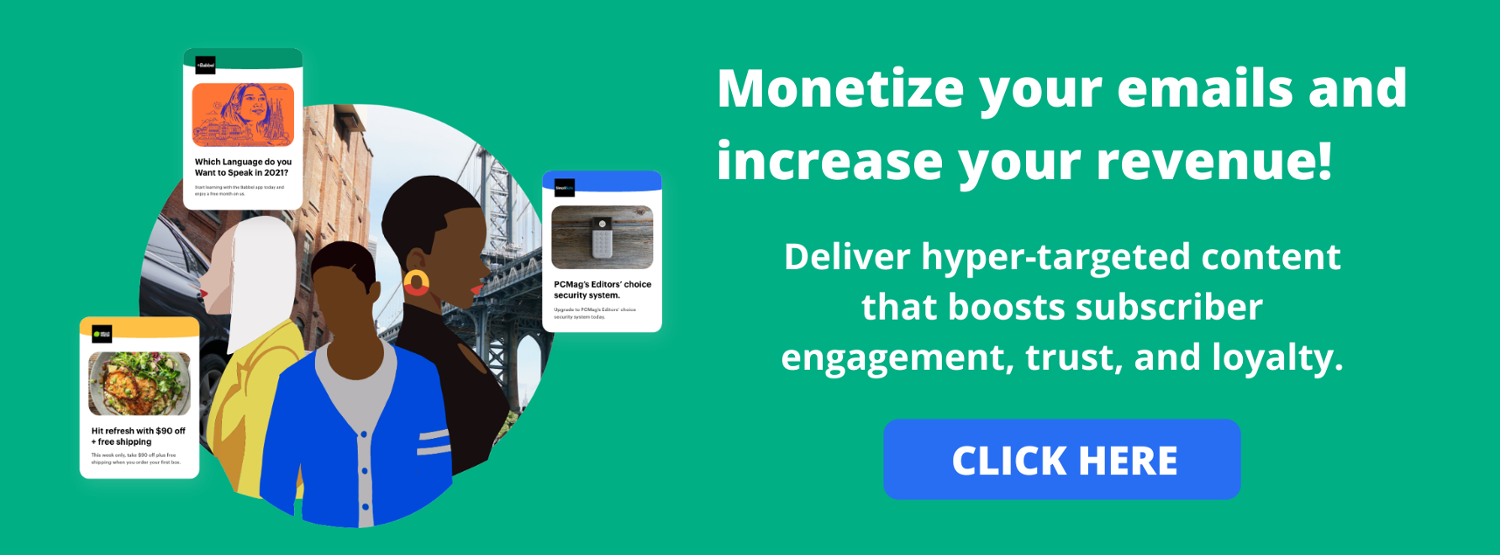Email, being one of the oldest forms of communication on the web, has built up a reputation as a slow and often ignored channel among younger demographics (which it is not — if you don’t believe us, read this ebook).
Even worse, the way most companies are using email magnifies this perception problem — nothing is less engaging than generic copy lifted directly from the website!
If you want to take your email marketing to the next level, you’ll need to put your campaigns on the same level as the rest of the products at your company. After all, what’s more important than securing — and retaining — loyal customers?
Below we’ll explore some of the common pitfalls in personalized email-based advertising and discuss how you can tweak your campaigns to tap an established and highly-engaged market.
How email is typically used
Email is one of the older internet marketing channels, with one of the first digital marketing advertisements being sent to several hundred email recipients in 1978. While the formats and language have changed, the content itself is remarkably the same – leverage previously-created media for traditional print and multimedia campaigns, and simply republish it as a mass message to your client base. This is a cheap and effective way to get your sales flyers out to your customers, and doesn’t take much more effort on top of what you’ve already done in building the web version of the content in the first place.
Pitfalls of general approach
This approach, unfortunately, is about as effective as print advertisement is for online consumers. To demonstrate this, here’s a small experiment you can run:
- Go check your email inbox.
- Look for a newsletter from any established retailer that you have purchased from – think Macy’s, OfficeMax, and other entrenched legacy retailers, if you can find any that have made it through your spam filter or that you haven’t yet unsubscribed from.
- Evaluate the content against the website’s print and multimedia campaigns.
Below is an example from my inbox:

I play brass instruments — trumpet, baritone, euphonium, cornet, and tenor horn. I’ve also purchased products for each of these instruments from this retailer. But the first thing I see in their imagery is two woodwind instruments, neither of which are related to my interests. Sure this product assembly might catch your “average person” with an “interest in musical instruments,” but music is a unique beast in that if you play euphonium, it’s not very likely that you’ll be in the market for a soprano saxophone.
This website is a niche website whose users have highly targeted instruments. It’s not often that a person plays multiple different classes of instruments, like both saxophone and trombone. This email is already missing targets in its marketing just based on the collection of instruments presented. Furthermore, I have made several purchases from this website in the past — stands, mutes, mouthpieces, music books, and metronomes, among other things.
They have multiple points of data on what I look for, including search results. None of these have been applied to the email I received — the closest instrument to anything I was interested in above is the trombone, which may be there because I searched for “trombone mute for tenor horn.” Of course, given the rest of the targeting, that trombone may just be there by accident.
Count the missed opportunities in this message, and you’ll soon realize that you’re only seeing a small portion of the overall message. They’re sending a broadcast based on a holiday sale, yet they have a treasure trove of data sitting in their databases that could help them more accurately target me. Sure, that data gets used to update the flashing banners and notifications on the web portal, but it rarely makes its way to the reader’s inbox. This is a critical missed path — personalization is what drives users’ interests and tells them that you are paying attention to the things that they’re already telling you that they want.
Using personalized web browsing
The advent of modern web development practices, and design principles, has opened up the world of personalized advertising. By tying the user’s browsing experience together with your application data, you can easily create highly-targeted advertisements in exactly the locations where you already have your users’ attention. By suggesting improved options or — even better — synergistic products that are commonly purchased based on the user’s purchase history, you can greatly enhance the reception and conversion rates of your web advertisements.
Improving personalized browsing with cookies
We’ve already mentioned the first traditional evolution of this approach. By leveraging the data already in your database about lead sources (you are tracking lead data, right?), purchases, and other demographic information, you can create highly-targeted ads that are more likely to pique the interest of your average reader.
Using small text files called cookies, you can track users as they move throughout your website, both gaining new tracking data as well as maintaining that data between sessions in a server-independent manner. With the ability to localize and target specific customer segments, personalized browsing experiences show significantly more potential than broadcast-based traditional email schemes.
While cookies bring a lot of power to same-domain advertising, their true revolution was in the ability to track third-party data as the user moved throughout the web. By placing advertisements and tracking pixels on third-party websites, advertisers could now incorporate standard user browsing behavior into their online marketing, reacting live as a user searched on different sites for their next purchase.
Pitfalls of cookie-based advertising
While cookie-based advertising offers a significant improvement upon the targeting present in traditional email marketing, it comes with its own pitfalls. The most common pitfall is the question of control. Simply put, the ability to control the data in your cookies rests in the hands of your users, and is not something you can easily influence without raising moral questions around privacy in web activity.
Web browser manufactures are further complicating this tenuous situation by actively enhancing and broadcasting to users their ability to disable your valuable tracking mechanisms. As customer privacy continues to be at the forefront of societal discourse, these types of restrictions are only likely to grow.
Plus, it was recently announced this year that Google Chrome will be implementing several changes to their browser that will eliminate the third-party cookie altogether. But don’t worry, we put together an entire blog post discussing how email can be the cure to your cookie woes.
Superiority of email
As the privacy discussion decimates the ability of cookies to drive marketing personalization, many organizations are casting around for a replacement. However, many more traditional retailers are focused on how to recover their online presence. In doing so, they’re likely ignoring their most overlooked strength — the established pipeline they already have for delivering targeted content to an engaged customer base: email.
By marrying the web technology generating your advertisements on your front page with the tech driving your email marketing, you can more accurately and effectively capture the attention of your audience. Through clever use of the data you’re already collecting on your customers, you can create a personalized message that can catch the attention of your customers through related products, add-on experiences, and other secondary purchases that can be made in support of their general activity history. This is all doable without the privacy concerns inherent in a third-party cookie approach.
Releasing an email product
Properly taking advantage of this new pattern requires a new approach to your email content. Where before you could simply cut-and-paste your more traditional marketing material into an email format, modern retailers will need to be more creative. Implementing that creativity, though, is not a simple proposition. There are data pipelines to be established, customizable content to write, and database queries and application code to support message generation.
All of these call for a dedication of resources above and beyond that of a traditional email marketing campaign. But, with the demonstrated value of personalized marketing being impacted by the reduction in capability due to cookie restrictions, this is effort you’d need to undertake anyway.
Treat your email as a first-class citizen in your quarterly planning. If you think ahead to the email system you want to build, you’ll not only be able to more effectively drive the implementation, but you’ll also be able to more accurately measure the ROI on your email marketing efforts. Building metrics and reporting around your email campaigns is a feature built into most mass-mailing providers, and can be used to drive content experimentation, bounce resolution, and more from a platform that has been reliable since 1974.
Conclusion
As privacy concerns take center stage, AdTech tends to suffer disproportionately. While we can make the valid argument that this is largely due to the bad behavior of a small number of poorly-acting advertisers, the practical upshot is that AdTech customers need to up their marketing game to stay competitive.
By leveraging the same personalization tech that drives your web advertising in your email messaging, you can evolve a stable and under-utilized channel with a direct line to your customers. With the evolution of privacy, your email marketing is going to quickly become your most important product, so it’s critical to ensure that it’s engaging, informative, and personalized.
And before you go, we think you’ll find the results of our latest survey quite interesting. You may think you know about consumer preferences when it comes to digital advertising, but don’t be so sure. Check out the myths we busted in our blog here.
—
And as always, if you’re interested in leveraging email to reach a highly targeted and engaged audience, get in touch.




